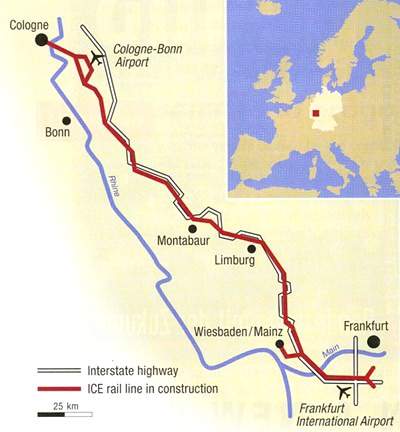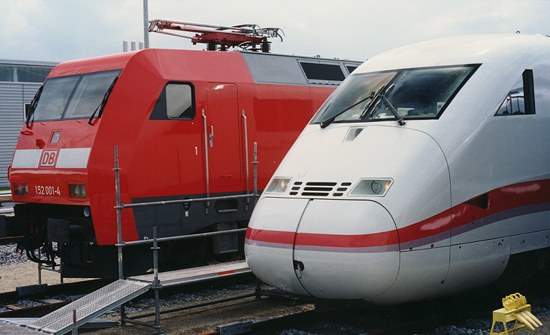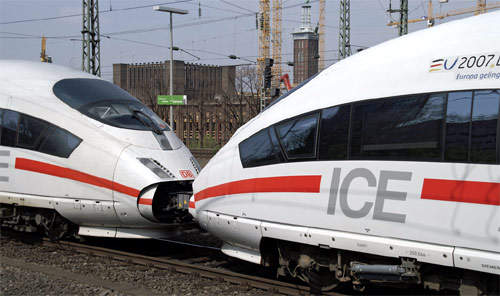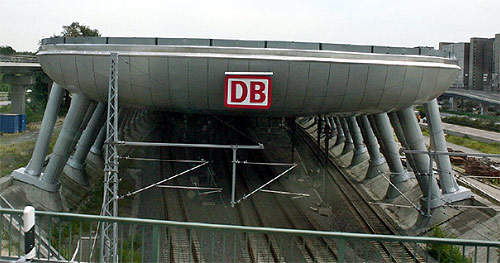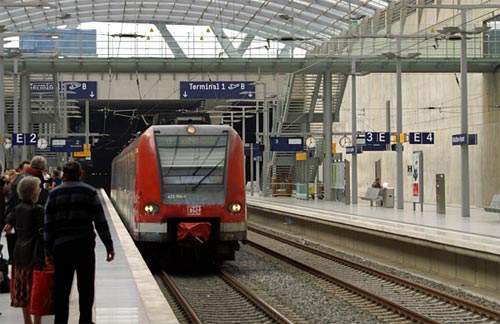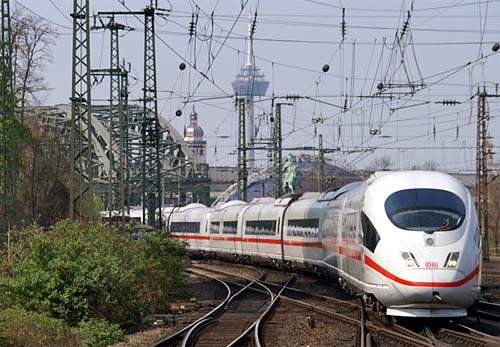German Railways (Deutsche Bahn – DB) is now a major player in European high-speed rail travel with its Inter City Express (ICE) programme. Deutsche Bahn AG came into being on 1 January 1994, following the passing of the General Railway Restructuring Act the previous year. It is now a holding company divided into three broad groups: passenger transport; transport and logistics; infrastructure and services.
These moves allowed the network to benefit from outside investment, although the German Government continues to invest in DB. The first new-build high-speed lines (Neubaustrecke – NBS) were Hannover-Würzburg and Mannheim-Stuttgart.
These allowed DB to introduce the first-generation ICE trains on a Hamburg-Hannover-Fulda-Frankfurt am Main-Mannheim-Stuttgart-Munich route, and soon afterwards, between Hamburg / Bremen, Hannover, Würzburg, Nürnberg, Augsburg and Munich.
The entry into service of the first 60 ICE1 trainsets enabled a two-hourly Munich-Berlin service to be inaugurated, saving an hour on journeys between Frankfurt and Berlin. At the same time, the Hamburg-Frankfurt line, known as ICE Line 3, was extended to Karlsruhe, with some trains running through to Zürich and Interlaken in Switzerland.
The project
Taking 13 years to plan and approve, and just six years to build, the Frankfurt-Köln line is seen as the third vital link in Germany’s ICE network, after the Würzburg-Hannover and Hannover-Berlin routes.
German national airline Lufthansa has scrapped its schedules on this important south-north Frankfurt- Köln communication axis, because ICE timings for the 226km (140 miles) trip fell from 2hr 15min via the classic Rhine Valley route to just under an hour.
DB expects passenger numbers to more than double by 2010 to around 20–25 million. This effectively links two of Germany’s most active economic regions, the Rhine-Main area (population 3 million) and the Ruhr region (population 10 million).
Infrastructure
The 177km (110 miles) Köln-Frankfurt NBS is more technologically advanced than its predecessors and the first designed for commercial use at speeds over 300km/h. It sees the first application in Germany of ballastless track. First trialled in 1993, seven different types of installation were tested on a 3.3km (2.1 mile) stretch of the Rhine Valley mainline.
A major engineering challenge was a new 2,375m tunnel near Limburg, which takes the line directly under the massive manufacturing plant of the TetraPak packaging company. For each metre of new tunnel, 7m of concrete lining is installed, and then removed as each new section is started. Other work has included 30 tunnels, 18 viaducts and 7,000 smaller structures.
The Frankfurt-Köln line differs from previous German high-speed lines in being designed purely for high-speed trains, rather than mixed-use, specifically assuming the capabilities of the distributed power ICE3 sets. It allows the inclusion of very steep gradients (as much as 4%) and makes the line closer in concept to French TGV lines. As with other later NBS, the line is bundled with an autobahn, the A3, to concentrate environmental impact.
Three intermediate stations are provided at Limburg Süd (the only DB station to have exclusively ICE services), Montabaur and Siegburg. To serve Germany’s busiest airport, the new Frankfurt(M) Flughafen Fernbahnhof and a 19km (12 mile) line to segregate long distance services from DB Regio and S-Bahn opened in 1999.
At the northern end of the NBS, a 15km loop and station serving Köln/Bonn Flughafen (Cologne Bonn Airport) which opened in June 2004, although not on the NBS, is considered part of the project.
Rolling stock
The third generation ICE3 (DB Class 403), in fleet service from 2000, was earmarked for use on the Köln-Frankfurt NBS where it handles all services, often running as in pairs. Designed with the prime aims of reducing train weight and fuel consumption, the Siemens / Adtranz (now Bombardier)eight-car ICE3 features a distributed traction package with every second vehicle powered, rather than the end power cars used for ICE1 and 2.
The ICE3M variant can run under up to four different voltages, to allow cross-border operation into Belgium and Holland and eventually France. Several DB Class 215 diesel locomotives were modified to act as dedicated rescue locomotives at strategic points along the line.
Signalling and communications
As befits the new stretch of line’s position as the most technologically advanced in Germany, it boasts a pioneering signalling system. This has involved completely dispensing with traditional lineside signals on two-thirds of the route in favour of a radio-controlled system.
A derivative of automatic train protection, known as Computer Integrated Railroading (CIR), is based on shorter fixed block sections rather than traditional lines. Shorter sections are used where line speeds are low. Drivers do not follow lineside signals but are instead guided by in-cab displays showing the status of the line ahead. DB has dropped the unproven ETCS/ERTMS system.
The future
The limited service opening in August 2002 was two years late. However, the impact on inter-city services was felt across Germany as the new timetable was introduced from that December. ICE3 sets also improved international routes from 15 December 2002, with sets working regularly from Frankfurt-Amsterdam (in connection with Netherlands Railways) and Frankfurt-Brussels (in competition with Thalys) using multi-voltage trains.
The new line’s proximity to the ‘Frankfurter Kreutz’, Germany’s busiest autobahn interchange, also holds out the possibility that many once-staunch car users may, on seeing the sleek ICE trains passing by as they wait in traffic queues, decide to switch their allegiance to the train.
The intermediate stations have succeeded in their park and ride role by encouraging commuter traffic from road to rail. Continuing expansion of the European high-speed network is likely to see more long distance services being routed via the Frankfurt-Köln NBS.
With a major airport at either end of the NBS, the opportunity for transfers and changing flights using trains rather than planes already sees DB and Lufthansa working together to provide new options for travellers.
The route not only supports air travel as a feeder to long-distance flights but also raises the competitiveness of rail against short haul flights.

